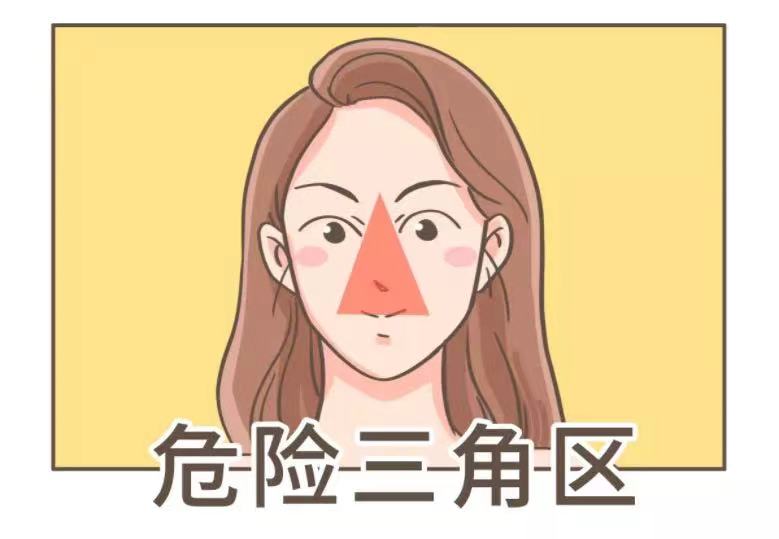Danger triangle
What is the danger triangle?
The danger triangle primarily refers to an isosceles triangle formed by the corners of the mouth on both sides and the root of the nose [1].

Why is the danger triangle "dangerous"?
-
First, from a local anatomical perspective, ordinary veins typically contain numerous valves. These valves act like gates, allowing blood to flow in one direction while preventing backflow. However, the veins in the danger triangle lack valves, enabling blood in this area to flow backward into the skull.
-
Second, the veins in the danger triangle run through facial muscles. When these muscles contract, they can also cause blood to flow back into the skull.
-
Third, the danger triangle area contains abundant sebaceous glands and hair follicles, making it prone to boils and carbuncles. For this reason, improper handling of boils in this area can lead to severe consequences, even death. Many painful clinical lessons have resulted from this, hence the name "danger triangle" to remind people to exercise extreme caution [1].
What happens if you squeeze a pimple in the danger triangle?
Squeezing, scratching, picking, or accidental injuries from shaving, as well as improper treatment of local lesions in the danger triangle, are often the main triggers for the rapid spread of infection. The infection can travel through blood vessels connecting to the skull, with bacteria spreading via the angular vein and ophthalmic vein to the cavernous sinus at the base of the skull, forming intracranial abscesses. The consequences are extremely severe, difficult to treat, and carry a high mortality rate [1].
What are the symptoms of an infection in the danger triangle?
-
Skin nodules and cysts: The infection spreads deep into the skin, causing solid or hollow inflammatory lesions resembling subcutaneous bumps, accompanied by redness and swelling.
-
Pain: Significant inflammation may be accompanied by pain.
-
Vomiting: Projectile vomiting may occur.
-
Cavernous sinus infection: Main symptoms include high fever (39.1°C–41°C), swollen eyelids, headaches, etc.
How is an infection in the danger triangle treated?
Medication: Common drugs include ceftriaxone and cefuroxime, which can combat infection and are suitable for patients with intracranial infections. These must be used under a doctor's guidance. Possible side effects include rashes, itching, edema, fever, and indigestion. Those allergic to these drugs should avoid them [2]. If symptoms like dizziness, headaches, vomiting, or fatigue occur, seek medical attention immediately.
How should pimples in the danger triangle be handled?
-
When inflammatory pimples first appear in the triangle area, avoid squeezing them directly. Instead, apply fusidic acid cream or mupirocin ointment to help reduce swelling and pain.
-
When a pimple develops a white pus head, apply ichthammol ointment to the area to help it mature and soften.
-
When the pimple matures, use a sterilized needle to puncture and drain the pus, aiding recovery [2].
How to care for the danger triangle?
-
Strictly follow medical advice when using medication. Changing drug types, dosages, or treatment durations without approval can hinder recovery or worsen the condition.
-
Develop healthy habits, maintain a regular schedule, and avoid staying up late.
-
Avoid touching pimples with unclean hands during recovery to prevent infection.
How to prevent pimples in the danger triangle?
-
Maintain a positive mindset and cheerful mood daily, avoiding tension and anxiety, which helps prevent emotionally triggered pimples.
-
Pay attention to personal hygiene, especially for those with oily skin. Wash your face and shower frequently (generally no more than three times a day), change clothes regularly, and keep undergarments clean. Also, maintain a tidy living environment and change bedding regularly.
-
Eat fresh vegetables and vitamin-rich foods like greens, spinach, broccoli, lotus seeds, lean meat, tomatoes, apples, grapes, and pomelos. These boost immunity, promote bowel movements, and help detoxify the body.
-
Avoid sweet, greasy, or spicy foods like desserts, barbecue, hot pot, fried skewers, and chocolate, as they can trigger or worsen pimples.